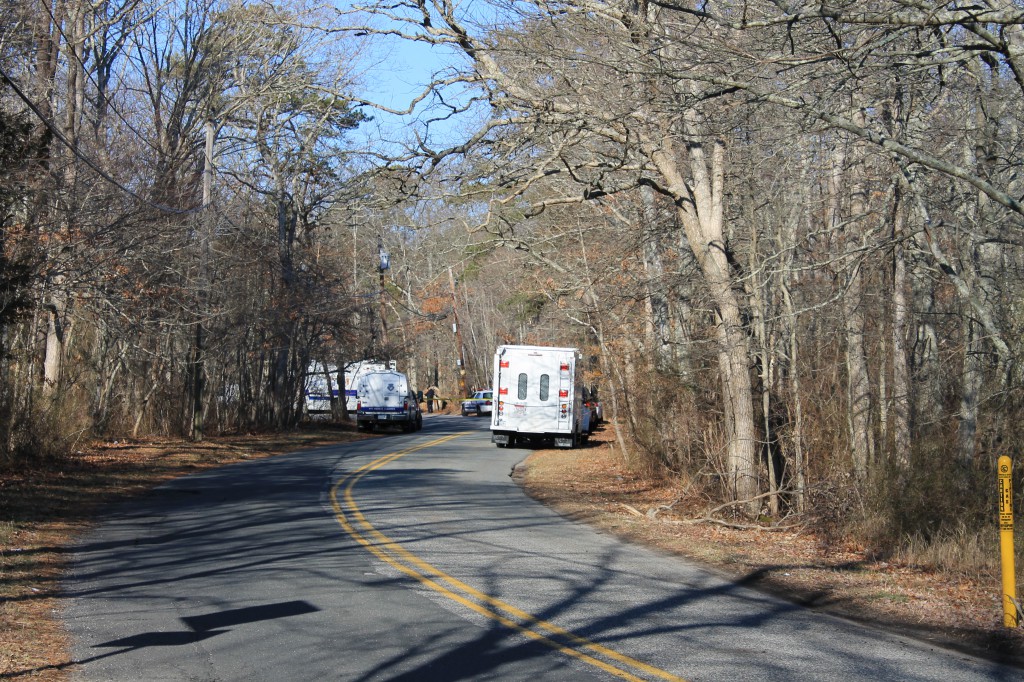Manorville Murders: Exploring LI’s Pre-Gilgo Cold Case Dumping Ground

On February 17, 2012, a hiker searching for deer antlers in the thick, sprawling woodlands of Manorville made a grim discovery: The skeleton of a man who, 10 years later, has yet to be identified.
The case is the latest unsolved homicide unearthed in the rural community considered the gateway to the East End. Located in the heart of the Long Island Central Pine Barrens — 100,000 acres of protected forest preserved to prevent pollutants from infiltrating the region’s aquifer that serves as its sole source of public drinking water — this was not the first dead body to turn up in this area that is desolate by design. Nor would it be the last.
“People say, ‘How come their families don’t come forward?’” says Joseph Giacalone, a retired New York Police Department homicide detective who commanded a cold case squad. “A lot of the time people just leave on their own and don’t want to be found. And then they come up like this, and then there’s no report on them, there’s no other information, maybe their family members have passed away. So it makes things rather difficult.”
The discovery is one of more than a half dozen sets of remains to turn up in Manorville over the past three decades. Before Suffolk County police found 10 sets of human remains in and around Gilgo Beach in 2010 and ’11 — an investigation that has spawned books and movies — it was the bodies found in Manorville that sparked fears of a serial killer on the loose on Long Island, although only two Manorville cases appear connected.
Suffolk police Det. Lt. Kevin Beyrer, commander of the Homicide Squad, declined to comment on the 2012 case through a department spokesperson, other than to say that the victim died of “homicidal violence” and that there were no updates in the investigation.
Medical examiners have determined the victim to be a man between the ages of 30 and 50 with brown hair who had recovered from a vertebral stress fracture and a broken fibula, or calf bone. He was wearing white-and-green tube socks and had on an extra-large Eddie Bauer waistband.
“I probably walked by it 100 times before, and I saw it kind of sticking out of the ground, and it looked unusual,” Matt Samuel, who made the discovery, told reporters at the time. “I looked a little closer and from there discovered that it was human remains. … It was wrapped in bed sheets and a plastic bag. It was a whole body, but just the bones, there was trees growing up through it, so it has been there a long time.”

COLD CASES
The earliest unsolved Manorville case also had the biggest breakthrough of late.
In 2020, Suffolk police made headlines when investigators identified a murder victim 20 years after her grisly discovery: Valerie Mack, a 24-year-old woman last seen in Philadelphia, whose nude, decapitated and partially dismembered torso was discovered by hunters in Manorville on November 19, 2000. Authorities had used forensic genealogy — searching for familial DNA matches in public databases — to identify her, although there has been no news on her case since.
Mack’s case is the one most clearly linked to another in the Manorville area, that of 20-year-old Jessica Taylor, whose remains were dumped in a similar fashion and discovered less than a mile away off Halsey Manor Road on July 27, 2003. The skulls and partial limbs of both women were found 11 years later and nearly 50 miles away off Ocean Parkway — some of the remains police found near Gilgo.
Mack’s isn’t the only unsolved Manorville murder in which investigators have made a breakthrough and put a name to the victim. But in the case of a man found on November 10, 2003 — five months after Taylor was found and 20 days before another unidentified man was found dead in nearby North Shirley — police have said the victim’s family asked authorities not to release the victim’s name when he was finally identified in 2015. The case remains an active homicide investigation, police have said.
His remains were uncovered in a wooded area about 300 yards south of the Long Island Expressway near Toppings Path and more than a mile west of Exit 71. The mushroom picker who made the grim find waited 10 days before reporting it to police because he was scared, but ultimately made the call after having nightmares, the New York Post reported at the time.
“The body looked decomposed, like it had been there three or four months,” the hunter told the Post, which didn’t print his name because he feared for his safety. “I was terrified, and I didn’t tell anyone except my wife.”
When the remains were first discovered, they were so decomposed that the sex was not immediately clear. A forensic anthropologist initially confirmed the remains as that of a 35- to 50-year-old man “with no trauma done to the skeleton,” police said at the time, the North Shore Sun reported. He was described as a white man, 5 feet 6 inches tall with brown hair.
Suffolk police declined to release any further updates on the case. County investigators have acknowledged how important a name can be in getting justice for unidentified murder victims.
“Some identification of who these people are will certainly give us an opportunity to backtrack and figure out what happened and why,” then-Suffolk Police Homicide Squad Det. Lt. Jack Fitzpatrick told The New Island Ear when police were trying to identify Mack and a still-unidentified man found strangled to death, two miles away in North Shirley, four days after Mack’s discovery. “Without identification there’s not a lot to go on.”

CLOSED CASES
Not all of the Manorville cases that grabbed headlines over the years have gone unsolved. The earliest of the group resulted in a conviction. Although it proved especially tragic.
On April 27, 1996, hikers found the skeletal remains of a child in the woods near Exit 70 on the Long Island Expressway. Investigators determined her identity, 4-year-old Jennifer Shafiq of Queens, in 2005. A year later, her mother was charged with second-degree murder and her father was charged with hindering prosecution for killing their child in 1990. They were later convicted.
Manorville’s reputation as a dumping ground drew some non-homicidal people to dump bodies there, as well. On March 21, 2012, a jogger found 45-year-old Pura Simancas of Central Islip dead in Manorville Hills County Park. Investigators later determined that she died of an accidental overdose and her boyfriend left her body in the woods. He was charged with improperly disposing of a body.
Other cases were more nefarious. On October 15, 2015, a driver on Wading River Manor Road in Manorville noticed a fire on the side of the road in the Otis Pike Preserve and discovered it was a burning body. The victim was later identified as German Guzman, 36, of Amityville. Two men, Bryan Rosales Mejia and Orlen Soliz-Galvez, later pleaded guilty to his murder.
In the most recent and local case of them all, on July 30, 2020, a home health aide found 37-year-old Carmelina Maria Velasquez-Zhau, a Manorville resident, dead in a wooded area just east of Winding Path. Her coworker who lived at the same home, Faustino Marquez-Cruz, later pleaded not guilty to second-degree murder in her death. His trial is pending.

SEEKING JUSTICE
As for the unsolved cases, Giacalone, the retired cold case investigator, is optimistic that a resolution could be on the horizon, now that the county has two new sets of fresh eyes from newly appointed Suffolk County Police Commissioner Rodney Harrison and recently elected Suffolk County District Attorney Ray Tierney.
“I’m really looking to see a lot of information coming out on these cases in the next few months with the new administration,” Giacalone says. “There’s a lot of things to be positive for to help identify these people.”
~With Long Island Press



